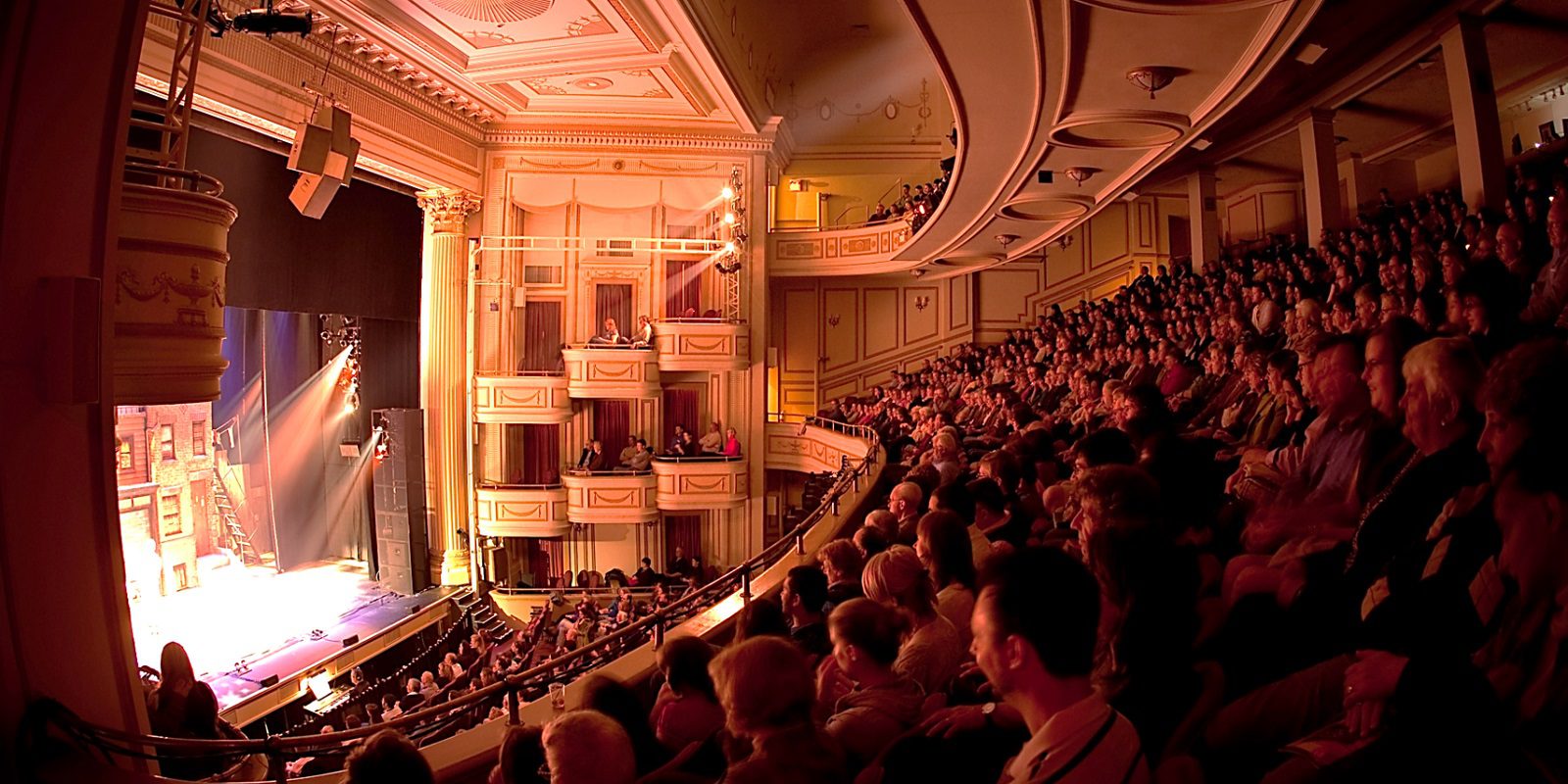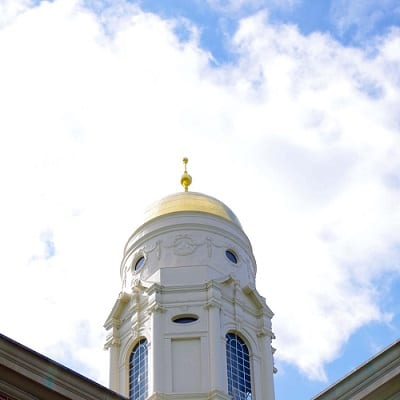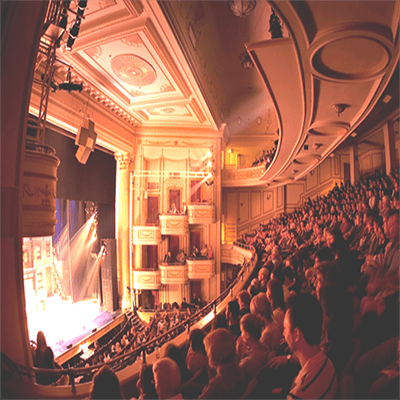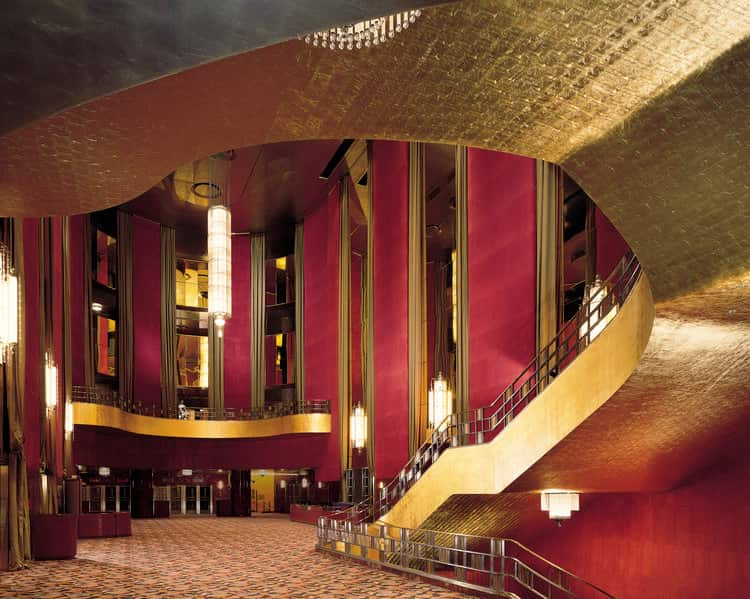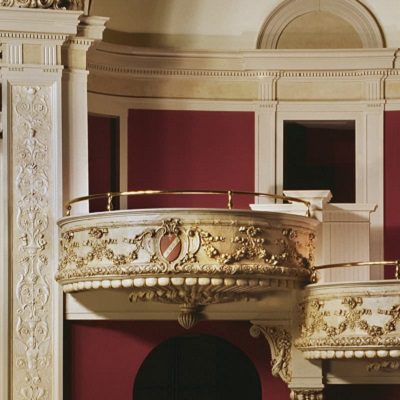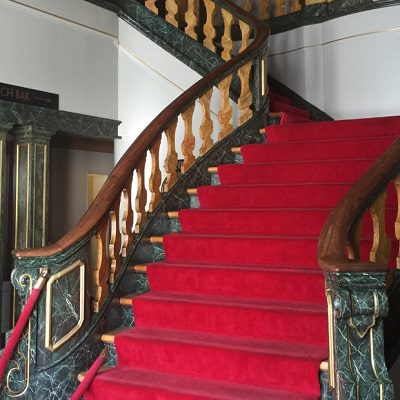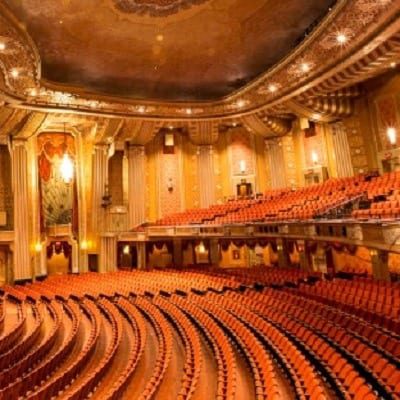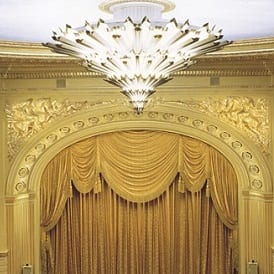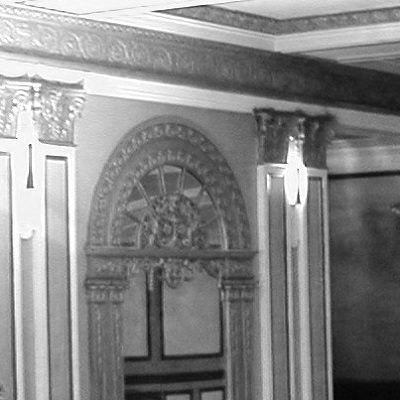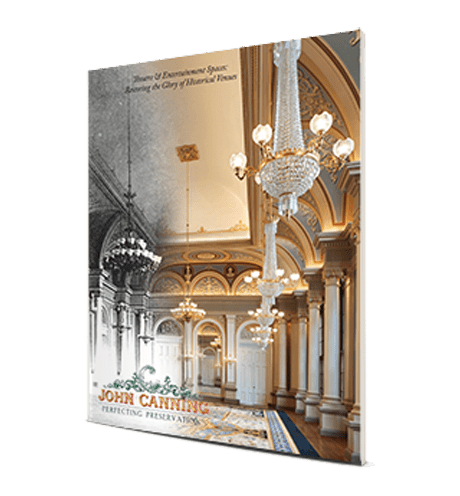People often remember Connecticut for its mix of coastal and rural towns, beautiful Mystic Seaport filled with ships and the aquarium, well-known Yale University, historic Mark Twain House, and the famous Peabody Museum of Natural History. Still, Connecticut’s hidden gemstones lie in its breathtaking landmark theaters. John Canning & Co. has had the privilege of working on theaters and entertainments venues restorations across the United States including some of these breathtaking theaters in this list. With every successful restoration it feels like you stepped back into a time machine and experienced what the theater felt like when it first opened, so hopefully you will have a chance to visit these and other historic theaters to visually experience these wonders. We are going to take a look at a few of these historic theaters in Connecticut.
1) The Warner Theater - Torrington, CT
The Warner Theater is an Art Deco-style theater with intricately painted ceilings and gilded walls that opened under the Warner Bros. chain of movie theaters in August of 1931. Nationally renowned architect Thomas W. Lamb, who specialized in designing theaters, designed the Warner with seating for 1,772 people, state-of-the-art technology, and lush, elegant decorations. However, in the 1950s, Warner Brothers sold the theater, and in 1955 the theater suffered from a flood. Therefore, by 1982, after years of neglect, it faced fears of demolition until a group of citizens formed the Northwest Connecticut Association for the Arts to raise money to save the theater. As a result, Warner closed its doors in August of 2002 to complete Phase One of its restoration, including clearing the 1956 seating, wall hangings, and temporary floor coverings. High scaffolding was put in to start the restoration on the auditorium’s stenciled ceiling, the silver and gold star-shaped light, and cleaning and gilding the complex pattern of the theater’s walls. In addition, the renovation restored the old brown-colored wall covering to its original vivid blood orange color; it brought in gold brocade draperies to accent the walls, replaced the act curtain, and decorated the lobby. The renovation also made the floors handicap accessible and updated the lighting, sound, and fire alarm systems. Currently, The Warner serves as a place for musicals, operas, plays, and other performances.
2) The Palace Theater - Waterbury, CT
The Palace Theater is a remarkable example of the Renaissance Revival Style that was opened in 1922 by Sylvester Z. Poli in the Main Street downtown area of Waterbury, Connecticut. The theater is an eclectic mix of Greek, Roman, Arabic, and Federal motifs, a grand lobby, and ornate dome ceilings that shows a wide variety of media, from silent films to live music. The Palace served as a centerpiece of the Greater Waterbury area, working with local businesses, arts, and more until it closed in 1987. However, The Tomasso Group gave the theater a 30-million-dollar restoration that allowed it to reopen in 2004 with its beautiful, richly decorated spaces across its four levels. John Canning Company over the years has repaired the plaster & decorative paints and worked to restore the grand lobby, mezzanine lobby, proscenium, and orchestra ceiling. Today it still serves the community with entertainment on the south side of Main Street.
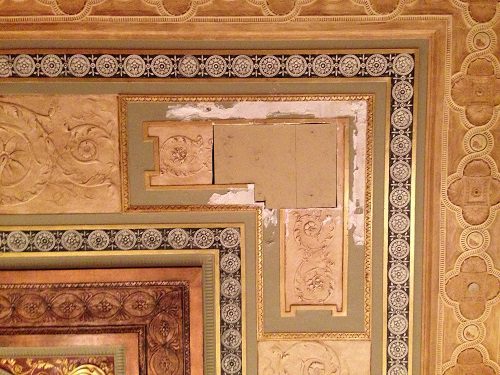
Some of the plaster repairs in process at the Palace Theatre.
3) Garde Arts Center - New London, CT
The Garde Arts Center sits in the historic downtown of New London, built-in 1926 to host motion pictures and other theater performances. Designed by Arland W. Johnson, the theater has a Moroccan-style interior with middle-eastern themed walls and murals by Vera Leeper. Even though the theater was adequate for showing films, it was too small to accommodate intermissions for a modern performing arts center; and faced demolition in 1985 but was saved. A restoration began to restore the velvet seats, gilded interiors, and equipment. Some new renovations included a unified lobby, performance venues, a multi-purpose function room, enlarged stage, new equipment, improved backstage and facilities, and handicap accessibility. In addition, the new two-story foyer has a restored historical look with curving walls and contrasting colors. Today, the Garde Arts Center promotes the artists of the greater New London area and hosts many performances from concerts, musicals, and comedy shows.
4) Shubert Theater - New Haven, CT
The Shubert Theater in New Haven, Connecticut, was erected in 1914 by the Shubert Brothers for live performances in honor of their brother Samuel Shubert. New York architect Albert Swazey designed the theater with the interior being a Neo-classical revival interior replete with golden ornaments. They included plaster floral swags, garland, crown moldings, egg& dart, dentils, and wall panels. Meanwhile, the exterior façade and trance were modernized in the 1980s when the City took ownership. Unfortunately, all of the original neo-classical details were destroyed. The theater opened with The Belle Of Bond Street performance, starring Broadway comedian Sam Bernard. Not only did the modernity of the theater bring guests, but its proximity to New York allowed it to become known as a “tryout venue,” hosting more than 600 town tryouts, 300 world premieres, and 50 American premieres. Some favorites it hosted included “Oklahoma,” “The King and I,” and “The Sound of Music.” Despite its long celebrity list of performances, the theater was almost demolished in 1976 but saved and restored. John Canning & Co. was part of the restoration team and consulted the theater for historic paint analysis, plaster reattachment, consolidation, as well as performed repairs to fix previous water damage. The company also performed decorative painting and application of metallic finishes on plaster and moldings. Additionally, they repainted all plaster surfaces with their original color scheme and painting techniques, such as the gilding to highlight the ornamental moldings. Today, the Shubert is a top theater in Connecticut, still showing a variety of live performances.
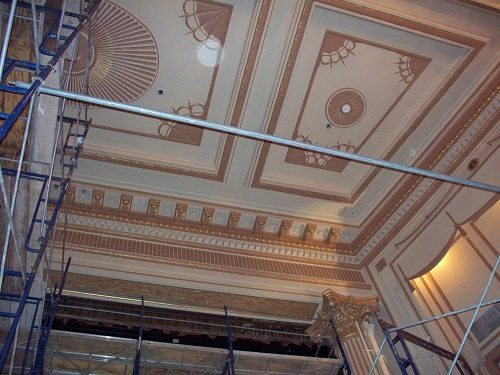
Shubert Theater restoration work in progress.
5) Lyric Hall - New Haven, CT
During the 1910s, the north end of Edgewood Park in New Haven had a small theater known as the Westville or West Rock theater to screen silent films, yet it did not last long. The building became an auto repair shop and then an antique shop until 2006 when John Cavaliere moved his Lyric Hall antiques and furniture restoring business to the area. According to the theater’s website, when Cavaliere purchased the building, the only thing left from the original vaudeville and silent movie auditorium theater was a small piece of the proscenium. So, after repairing the ceilings and floors, he resurrected the playhouse space using things from the past, like the almond-white balustrade he rescued from the Hyperion Theater that sat behind Union League Café. The room’s highlight is the scintillating Beaux-arts crystal and bronze-gilt chandelier hanging from the theater’s ceiling. It took six months to restore the 1912 artifact, but he says it was all worth it in the end. In late 2018 Cavaliere decided to sell the theater, hoping it could continue, but he continues to book events at the theater regardless.
6) The Bushnell - Hartford CT
The Bushnell is a beautiful, grand performing arts center in the Georgian Revival style built by father-daughter pair Horace Bushnell and Dotha Bushnell Hillyer to leave a permanent tribute to Dotha’s father, Horace. The theater opened in 1930 and, unlike most of the great theaters in the state, has remained open since its opening. The theater serves as a landmark of Hartford and houses several halls, theaters, and even a custom-made organ. John Canning Company also had a hand in restoring this historic theater. For instance, they performed consultation services that included paint analysis and investigations for the exterior and interior of the Horace Bushnell Memorial Hall Auditorium. They performed a visual assessment of the entire space and reviewed written documentation and early photos to establish the basis for their study. The company conducted some exposures and took selected samples from crucial architectural features to be examined microscopically at the lab. From this assessment, they determined the color stratigraphy and established a match to the Munsell Color Standard for original decoration. In addition, the company helped restore the theater’s famous golden dome and cupola and worked on paint removal, selective sheet metal repairs, caulking/sealing, painting, and gold leaf gilding of the dome. Today, the Bushnell continues to serve generations of Connecticut citizens with its numerous Broadway tours, live music, plays, ballets, and more.

Bushnell dome gilding.
7) Wall Street Theater - Norwalk, CT
The Wall Street Theater opened in 1915 with a performance of “Everywoman” starring Earle Williams. Initially purchased by Samuel Kantor, The Regent featured many vaudeville acts and the most significant motion pictures showcased on its large colorful marquee, which has been removed. People used the space for performances, community events, and even political events like the Republican rally on October 29, 1920. During the Great Depression, The Regent lost lots of revenue, but the community decided it would be best to convert the space into a movie theater to create affordable entertainment. After renovations, it became the finest in New England, hosting significant events such as Elvis. However, many worried that the theater would become a historical architectural piece with little patronage after the renovations. Those fears were realized when the theater closed in October 1989 after it couldn’t keep up with the other more accessible movie houses in the area. However, there were a few more attempts to revive the theater until an extensive renovation returned the 102-year-old building into a versatile multi-purpose performance space with a new name, the Wall Street Theater. The renovations changed light opera and amplified music systems, removed old fixed seating, and replaced the sloped floor with a flat floor. The theater’s 1930s rigging system was removed and replaced, and the stage itself was restored with a sprung floor. Restorers modernized the rest of the theater with new amenities and state-of-the-art systems, keeping its history, style, and architecture.
8) Goodspeed Opera House - East Haddam, CT
In 1963, the Goodspeed Opera House opened as a professional musical theater on the historic banks of the Connecticut River. William Goodspeed, a merchant and banker, built the theater in 1876, and it originally served as a store, office, and steamship docking point with a theater on its two top floors. The Goodspeed was built in the Second Empire style to attract the attention of those on the river. The first performance at the Opera House began on October 24, 1877, but Godspeed closed in 1926, becoming a building of various purposes, such as when the militia used it during World War I. However, after falling into disrepair, it was restored in 1959 by Goodspeed musicals and has continuously hosted musicals with over 70 world premieres. John Canning Company has also worked on the staircase dedication and restored the decorative finishes throughout the theater.
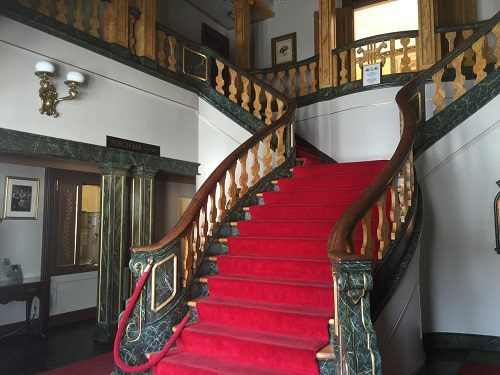
Goodspeed Opera House staircase.
Each of these theaters has impacted Connecticut and its local town. Whether they served the community with entertainment, worked with local businesses to promote art, helped the military during the world wars, or hosted myriad events from Broadway, concerts, and government performances, these historic theaters remain an integral part of Connecticut’s booming entertainment industry. Likewise, they serve as a past landmark and allow visitors to honor and experience history from many decades ago.

